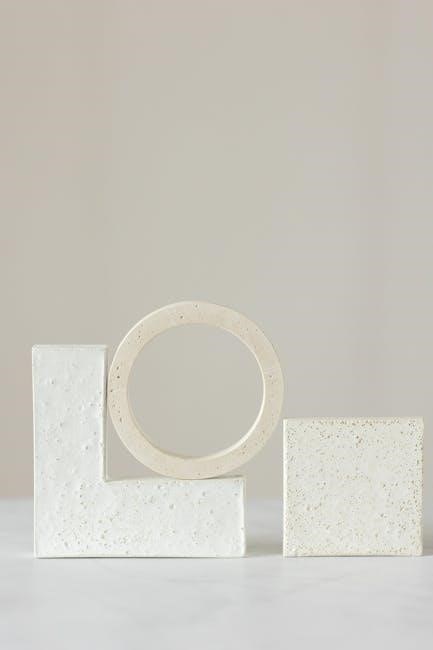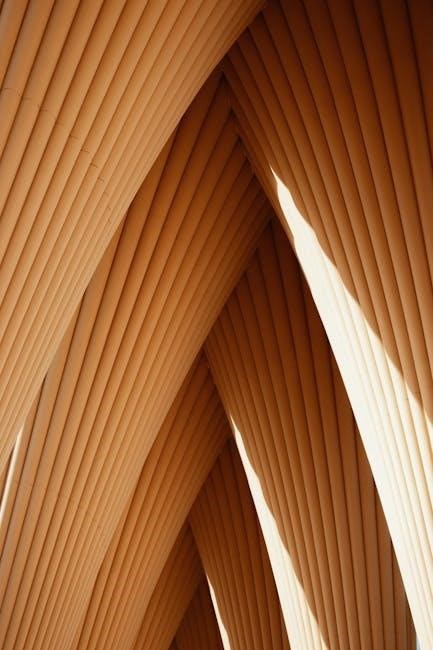Composite shapes are complex figures formed by combining simpler geometric shapes like rectangles, triangles, and circles. They are essential for solving real-world design and measurement problems.
1.1 Definition and Examples of Composite Shapes
Composite shapes are formed by combining two or more basic geometric figures, such as rectangles, triangles, or circles. These shapes are often irregular and require breaking them into simpler parts to calculate their areas. Common examples include L-shaped figures, house outlines, or complex polygons. They are widely used in real-world applications like architecture, design, and engineering to solve practical problems involving measurements and spatial calculations.
1.2 Importance of Calculating Areas in Real-World Scenarios
Calculating areas of composite shapes is crucial in various real-world applications, such as construction, interior design, and landscaping. It helps determine material requirements, costs, and spatial planning. For example, painters use area calculations to estimate paint needed, while architects use them to design efficient spaces. Accurate measurements ensure projects are completed within budget and meet functional needs, making this skill indispensable in practical problem-solving scenarios.

Step-by-Step Process for Calculating the Area of Composite Shapes
To find the area of composite shapes, break them into simpler shapes like rectangles and triangles, calculate each area, then add or subtract to get the total.
2.1 Splitting the Shape into Basic Figures
Start by identifying and dividing the composite shape into simpler geometric figures like rectangles, triangles, or circles. This step ensures accurate area calculation by isolating each component, making it easier to apply specific formulas to each part. Carefully draw lines to separate the shapes and label them for clarity. This systematic approach prevents errors and simplifies the overall process, ensuring each section is accounted for individually.
2.2 Calculating the Area of Individual Components
Once the composite shape is divided, calculate the area of each basic figure separately. Use the appropriate formulas: for rectangles, multiply length by width; for triangles, use ½ base × height; and for circles, apply π × radius². Ensure all measurements are in the same unit before computing. This step-by-step method ensures precision and avoids confusion, laying a solid foundation for the next calculation phase. Accuracy here is crucial for the final result.
2.3 Adding or Subtracting Areas to Find the Total
After determining the areas of individual components, sum them to find the total area of the composite shape. If parts overlap or are excluded, subtract their areas accordingly. Ensure all units match for consistency. This method provides an accurate representation of the entire figure’s size, making it practical for real-world applications like construction or design projects where precise measurements are essential for planning and execution.

Understanding Different Shapes Within Composite Figures
Composite figures often combine rectangles, triangles, and circles, each with unique properties. Recognizing these shapes is crucial for accurate area calculations and real-world applications.
3.1 Rectangles and Their Area Calculations
Rectangles are four-sided figures with opposite sides equal and all angles 90 degrees. Their area is calculated using the formula: area = length × width. This formula is fundamental in composite shapes, as rectangles often form the base or additional components; For example, a rectangle measuring 5m by 3m has an area of 15m². Regular practice with worksheets helps master this calculation.
3.2 Triangles and Their Role in Composite Shapes
Triangles are essential components in composite shapes, often used to adjust or extend areas. Their area is calculated using the formula: area = ½ × base × height. Triangles can be right-angled, isosceles, or scalene, and they frequently complement rectangles in forming complex figures. Worksheets and practice problems help students understand how to break down composite shapes into triangular components, ensuring accurate area calculations. Regular practice enhances this skill.
Applying Area Formulas for Basic Shapes
Mastering area formulas for rectangles, triangles, and circles is crucial. Worksheets provide exercises to apply these formulas, aiding students in solving composite shape problems effectively.
4.1 Area of Rectangles (Length × Width)
The area of a rectangle is calculated by multiplying its length by its width. For example, a rectangle measuring 5 meters in length and 3 meters in width has an area of 15 square meters. This formula is fundamental for solving problems involving composite shapes, as it often serves as a building block for more complex calculations. Regular practice with worksheets ensures mastery of this essential skill.
4.2 Area of Triangles (½ × Base × Height)
The area of a triangle is calculated using the formula ½ × base × height. This formula is crucial for determining the area of triangular components within composite shapes. For instance, a triangle with a base of 4 meters and a height of 6 meters has an area of 12 square meters. Worksheets and practice problems help students apply this formula effectively in various geometric scenarios.
4.3 Area of Circles (π × Radius²)
The area of a circle is calculated using the formula π × radius². This formula is essential for determining the area of circular components within composite shapes. For example, a circle with a radius of 3 meters has an area of 9π square meters. Worksheets often include circular areas in composite figures, requiring precise calculations. Always use π (3.1416) for accuracy unless specified otherwise.
Practical Examples and Problem Solving
Practical examples demonstrate how composite shapes apply in real-world scenarios, such as calculating paint needed for a house or determining the maximum number of chickens in a field.
5;1 Step-by-Step Solutions for Composite Shape Problems
Solving composite shape problems involves breaking down complex figures into simpler shapes. For each, calculate areas individually using formulas like length × width for rectangles or ½ × base × height for triangles. Sum or subtract these areas to find the total. For example, a house’s wall area might combine rectangles and triangles. Ensure units are consistent and round answers appropriately for practical applications.
5.2 Real-World Applications (e.g., Painting, Construction)
Composite shapes are crucial in real-world scenarios like painting and construction. For instance, calculating the area of a house’s wall, which may combine rectangles and triangles, helps determine paint quantities. Similarly, in construction, understanding composite areas aids in material estimation and space planning. These skills ensure efficiency and cost-effectiveness in various practical projects, making them indispensable for professionals and learners alike.

Tips for Accurate Calculations
To ensure accuracy, avoid common mistakes like incorrect formula usage or miscalculations. Always double-check measurements, round appropriately, and use consistent units throughout your computations.
6.1 Avoiding Common Mistakes

Common errors include incorrect identification of shapes, miscalculating areas, and improper rounding. Ensure accurate measurements and apply the correct formulas. Always verify each step to avoid mistakes. Double-checking calculations and ensuring consistent units are crucial. Properly label each section and avoid mixing units like centimeters and meters. Regular practice helps minimize errors and improves accuracy in solving composite shape problems effectively.
6.2 Rounding and Units in Final Answers
When presenting final answers, ensure proper rounding based on the problem’s requirements. Round to the nearest whole number or decimal place as specified. Always include appropriate units, such as square meters or inches. Consistency in units is crucial for clarity. Proper formatting enhances professionalism and accuracy in solutions, making results clear and understandable for practical applications and real-world scenarios.
Worksheet Resources and PDF Downloads
Access free PDF worksheets for practicing composite shapes area calculations. Visit corbettmaths.com or mathworksheets4kids.com to download and print these valuable resources for mastering the topic.
7.1 Recommended Worksheets for Practice

For effective practice, download PDF worksheets from corbettmaths.com and mathworksheets4kids.com. These resources offer a variety of exercises, from basic to advanced, focusing on calculating areas of composite shapes like rectangles, triangles, and circles. Worksheet 69 and Area of Compound Shapes are highly recommended for comprehensive practice. They include step-by-step problems and real-world applications, ensuring a thorough understanding of the topic. Regular practice with these worksheets will enhance problem-solving skills and accuracy.
7.2 How to Download and Use PDF Worksheets

To access PDF worksheets, visit websites like mathworksheets4kids.com or corbettmaths.com. Click on the desired worksheet, such as Area of Composite Shapes, and select the download option. Once downloaded, print the sheets or use them digitally. Review the problems, calculate areas by splitting shapes into simpler forms, and check answers for accuracy. Regular practice with these resources will improve your understanding and problem-solving skills in calculating areas of composite shapes effectively.
Mastering composite shapes enhances problem-solving skills, aiding in real-world applications like construction and design. Regular practice with PDF worksheets ensures confidence and accuracy in area calculations.
8.1 Summary of Key Concepts
Composite shapes combine basic figures like rectangles and triangles. To find their area, split them into simpler components, calculate each area using formulas, and sum or subtract as needed. Regular practice with PDF worksheets reinforces these skills, essential for real-world applications like construction and design. Mastering composite shapes enhances spatial reasoning and problem-solving abilities, making them a fundamental math skill for practical and academic success.
Consistent practice with composite shapes worksheets strengthens your understanding of area calculations. Explore free PDF resources for varied problems, from simple figures to complex designs. Regular exercises enhance accuracy and confidence, preparing you for real-world challenges. Embrace these tools to refine your skills and excel in geometry and beyond. Keep practicing to master the art of breaking down and solving composite shape problems with ease.8.2 Encouragement for Further Practice
